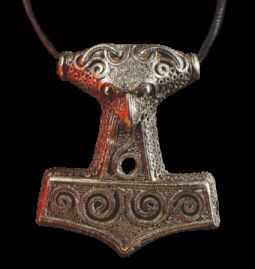
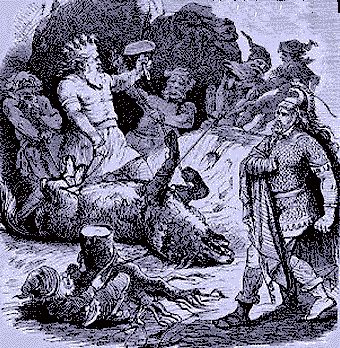
|
Home DH-Debate 4. Refugees from the Plains in Europe and China 6. Similarities Between Danish and Chinese Language |
Before the Scandinavians became Christians around the year 1000 AD, they worshiped the Old Norse gods, called the Asians or the Aesirs, described in the Edda poems - written down in Iceland around 1200 AD.
The Edda poems are populated by many different races, including Aesirs, Vanes, Elfs, Jats and Dwarfes. Who these races really were, and where they came from, will probably never be fully known - which uncertainty leaves room for imagination.
The Dwarfes of Scandinavian Mythology were known as skilled craftsmen. But they were often exposed to the envy and greed of the Aesirs.
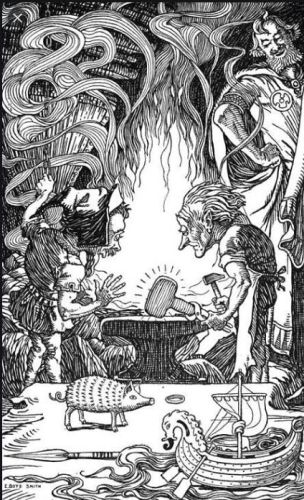
The dwarfs Sindre and Brok forge the hammer Mjoelner. In the foreground one can see other of their products: the boar Goldbristle, the ring Draupner, the Spear Gungner, Sif's gold hair and the ship Skidbladner. Drawing: Elmer Boyd Smith (1860 - 1943) - page 88 in Brown, Abbie Farwell (1902). "In the Days of Giants: A Book of Norse Tales" Illustrations by E. Boyd Smith. Houghton, Mifflin & Co. - Wikipedia.
The dwarf Ivalde's two sons, Sindre and Brok, made many valuable and unique things. They forged Thor's famous hammer, Mjoelner, which struck with great force and always returned to the hand of the man, who threw it.
They made Odin's magnificent gold ring Draupner. From the ring, every ninth night, eight new and equally magnificent gold rings dripped.
They created Frey's boar, Goldbristle, which had golden bristles that illuminated the World, and that could run over water and through the air and be used as a riding animal.
They built Frey's fantastic and magical ship, Skidbladner, which sailed just as well in headwinds as in tailwinds. When not in use, it could be folded up so it took up almost no space.
Sindre and Brok also created Sif's gold hair. It was of the purest gold, but stuck to the scalp and grew, like ordinary hair.
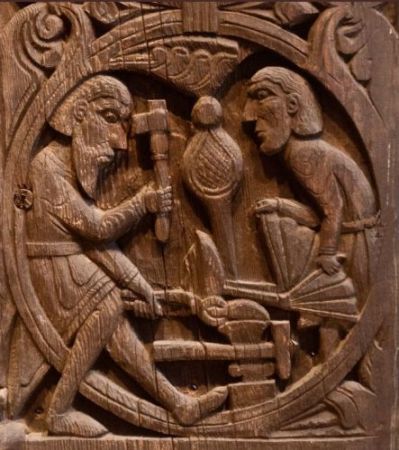
The dwarf Regin Regin re-forges the broken sword, Gram, with Sigurd at the bellows. Detail from the Sigurdportal in Hylestad Stave Church in Norway from 1175. Photo Twitter.
The fertility goddess Freja went so far as to spend a night with each of the four dwarfes who created the unique piece of jewelry, Brisingamen, for her. Their names were Alfrigg, Berling, Dvalin and Grerr.
Andvare was a very rich dwarf, who was robbed by the god Loke for everything he owned - including a ring, Andvarenaut. Andvare disappeared into a rock, casting the curse that he, who owned the ring, should die.
The dwarf Regin was the foster father of Sigurd Fafnersbane. He re-forged the sword, Gram, from Sigurd's father's broken sword. With this sword Sigurd killed the dragon Fafner, who guarded an immense gold treasure on Gnita Heath. Sigurd was given wisdom by licking the blood of the dragon and thereby he became able to understand the language of the birds. They told him that Regin planned to kill him to take the gold himself. Then Sigurd killed his stepfather and took all the gold.
The dwarfes in the land of the Black Elfs made the wire, Gleipner, with which the Aesirs succeeded in tying up the Fenris Wolf. The wire was made of the fish's breath, the saliva of birds, the bears' tendons and the roots of the mountains, the noise of cat paws, and the beards of women. It was quite thin and looked of nothing - but extremely strong.
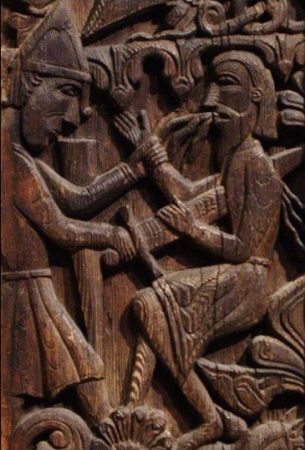
Sigurd kills his foster-father, Regin. Detail from the Sigurd-portal in Hylestad Stave Church in Norway from 1175. Photo Jeblad Wikipedia.
The Voelve's Divination is the first poem in Elder Edda, written down about 1200 AD in Iceland, but the stories themselves are probably much older. A voelve was a wizard-women, who could look into both past and future. The poem is formed like a monologue and it tells of the creation, destruction and resurrection of the World.
The dwarfes were created from the original giant Ymer's blood and bones, the divination says that it is water and mountains. Modsogner and Durin were the most distinguished dwarfes. In the Voelve's Divination is stated about the origin of the dwarfes:
"All Creators went
to the stools of destiny,
each higly sacred God,
and then had meeting,
about the multitude of dwarfes
which is created into life
from Brimer's blood,
from Blain's bones." *
"The greatest among them
Modsogner was,
but Durin became
the next for the dwarfes.
Many they created
with human traits
in the Dwarfes' Earth,
as Durin said."
*Brimer and Blain are the original giant, Ymer.
Apparently the dwarfes were very important people, at least they are all - each and every one - listed with name's mention in the dwarf list that is inserted in the Divination of the Voelve:
"Nye, Nide, Nordre, Sudre, Austre, Vestre, Altjof, Dvalin, Nar og Nain, Niping, Dain, Bivar, Bavar, Bambor, Nore, An og Anar, Ae, Modvitner."
"Veig og Gandalf, Vindalf, Torin, Tekk og Train. Tror, Vit, Lit, Nar og Regin, Nyrad, Radvid. There all the dwarfes are mentioned."
"File, Kile, Funden, Naale, Hepte, Vile, Hannar, Svior, Billing, Brune, Bild og Bure,
Frar, Hornbore, Fraeg og Lone, Aurvang, Jare, Eikenskjalde."
"Now all the Dwarfes in the flock of Dvalin until Lofar are counted - listen - Those who travelled from the Seabottom's Stones over the Dyndvangseat to the sandy soil."
"There were Draupner and Dolgtraser, Har, Haugspore, Hlevang, Gloin, Skirfer, Virfer, Skafid, Ae."
"Alf og lngve, Eikenskjalde, Fjalar, Froste, Fid og Ginnar. Until the end of the World one must always remember the descendants of Lofar, whom I listed here."
There is not much we know about the dwarves besides their names. But the Voelve's Divination says that they were similar to other people: "Many they created with human traits." But we must believe that they were smaller of stature than the Aesirs, since they were named dwarfes.
Snorre explicitly states that the Aesirs came from Asia. We can believe that they were originally one of many Indo-European tribes that lived on the Eastern Steppe, in the Tarim Basin or in the surrounding mountains.
However, it is known from other sources that the Xianbei tribes in particular - but probably also other peoples of the Eastern Steppe - used numerous Chinese people as administrators and probably also as specialists and craftsmen. One can believe that so did the Aesirs, and these Chinese people followed them, when they left the steppe and headed west to Scandinavia, and that the Scandinavian Dwarfes were their descendants.
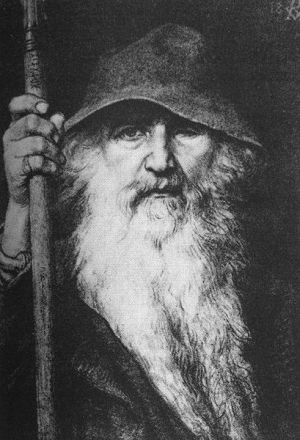
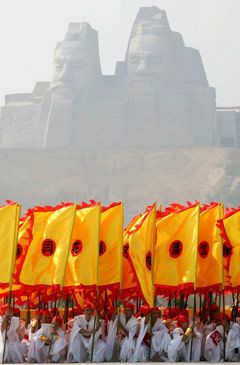
Left: Odin with the spear Gungner - Painting by Georg von Rosen 1886.
Right: Representatives from all over China, Taiwan and Chinese societies and Chinatowns from all over the World have met in Shaanxi to honour the ancestor of the Chinese race, The Yellow Emperor.
Numerous original peoples, Xianbei, Qiang and many others, which names by now are all forgotten, have abandoned their own language in favour of Chinese, in admiration of the emperor's glory and the Chinese culture. Modern Chinese are descendants after all these people, just in the same way as Europeans are descendants from countless original tribes.
For thousands of years, the Chinese called their Japanese neighbours for the dwarfs, because they were somewhat shorter in stature than themselves. This was just the way one expressed oneself in this part of the world.
The old Scandinavian myths tell us that the dwarfs lived in the soil and in the rock.
It was also, what some of the ancient ancestors of the Chinese did. In the provinces of Gansu and Shaanxi, many people lived in rock caves far up in history. Poor people still live in caves, that is houses, where the inside parts have been cut into the cliff.
One of our Chinese friends comes from the province of Shaanxi. She told, that her grandmother lived in a house dug out down into in the ground. A ramp is leading down into a three to four meters deep hole, and then the rooms have been dug out horizontally.
Both types of accommodation are said to be very comfortable both winter and summer, they always keep a convenient temperature.


|
Left: Thor's hammer - Mjolnir.
Right: The Aesirs tie up the Fenris Wolf with the thin wire supplied by the dwarfs.
In general, the relation between the Aesirs and the Dwarfs seemed to have been fairly amicable. In the Scandinavian myths, Thor was often away from Asgaard to combat the Jotuns. We never hear about, that he had gone to fight dwarfs.
Once Thor had been away for years for war campaigns against the Jotuns, a marriage between the learned dwarf Alvis - meaning all-wise - and Thor's daughter was agreed. However, he happened to come home in time to have it thwarted. About this is told in the poem, "Alvis-mal".
The Aesir's myth about the creation of the world is very similar to the Chinese creation myth.

The Chinese original giant Pan Ku.
The Chinese tell that in the beginning, everything was chaos. But when the two opposing forces, Ying and Yang, met each other, they created the Original Giant, Pan Ku.
With his own body, Pan Ku created the World. His head became a mountain, his breathing became the clouds and his voice became the thunder. His skin became the plains, his hair became the trees, his bones became the metals and his veins became the rivers. From the insects, which clambered on his body, humans were created.
The Aesirs myth tells us, that in the beginning there was a huge nothing called, "Ginnunga-gap". But when the ice and the cold from the northern Niflheim met with their opponents, the heat and the fire from the southern Muspelheim, then dew was formed in the middle of Ginnungagap, and in this mild climate the original giant, Ymer, was created.
The Aesirs, Odin, Vile and Ve, killed Ymer and out of his body, they created the World.
"Of the jotun-flesh of Ymer Earth was created
and from wound-sweat the sea;
Mountains from the bones, bushes of the hair.
The sky of the skull."
His blood became the rivers and the sea, his meat became the land and his bones became the rocks and the mountains. From the maggots, which lived in his meat, the Dwarfs were created. It was obvious, because it was well known, that the Dwarfs lived in caves in the soil, which really was the meat of the giant. Furthermore, the Chinese themselves had told, that they were created from some creep, which clambered around on the original giant.
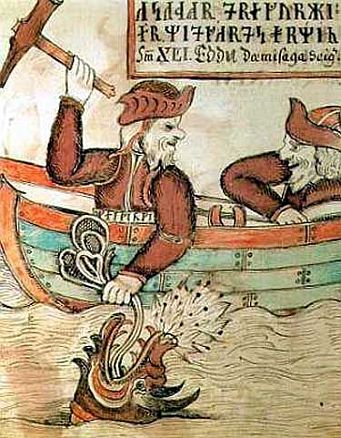

|
Left: Thor is on fishing together with Udgaardsloke and he gets the Midgaard-worm on the hook.
Right: Dragon from the Nine Dragon Wall in the Forbidden City
The Chinese dragons lived at the bottom of the lakes. The first and biggest dragon lived on the bottom of the World Ocean.
The Midgaard-worm was the largest dragon in Scandinavian mythology. It lived also on the bottom of the sea. In Asgaard, the original home of the Aesirs, it must have lived in one of the big lakes of Central Asia. Later on, it moved with the Aesirs to the ocean.
The Chinese Emperor's name of honour was "The Great Dragon", or "The Great Worm". The Emperor's throne was the Dragon Throne. His subordinates, the Chinese, was the Great Worms children, it means that they obeyed the Great Dragon in the same way as children obey their father.

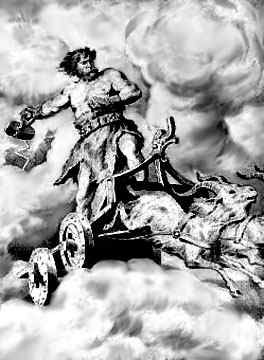
Left: The Chinese thunder god with a hammer with a short handle.
Right: Thor - the Scandinavian thunder god with Mjolnir - a hammer with a short handle.
In the old days, the Chinese emperor was greeted with three times shouting: "Long live the emperor". Danes have the same habit when celebrating somebody, but over time rationalized to: "Long live " and then 3 times "hurray".
In Zhaoqing in southern China, halfway between Guangzhou and the border with the neighbouring Guangxi province, is an exhibition park named "Seven Star Lake".
Here is a cave with 108 mythological figures, small statues, from ancient China; all made by the locals for entertainment and education.
These figures include a thunder god, "Da Lai Gong Gong", which means "Grandpa Thunder". He is armed with a hammer with a short handle, with which he produces the thunder. We recognize him as the Scandinavian thunder god Thor, or at least one of his close colleagues.
From Sichuan comes the myth about the god "Erlang". The stories about Erlang have some themes in common with Beowulf's journey to the Danish court and his killing of monster Grendels mother on the bottom of the lake, as well as with the fairytale about the Seven Dwarfs.
The King of Qin appointed Li Bing governor of Sichuan. The new governor organized the construction of an extensive system of dams and canals in order to improve farming and prevent flooding.

The seven mountain-men, who were Erlang's companions also appear in the folk tale "Snow White and the Seven Dwarfes," which was collected by the Grimm brothers in 1800's in Germany. Photo Landsbokasafn Islands Wikipedia.
His second son, "Erlang", helped him to build the advanced irrigation system, which today still exists.
However, by this time, before the system was built, the area was frequently hit by flooding.
Erlang was ordered to determine the cause of the disasters and prevent them. From spring to winter, he made a number of difficult travels, but he did not succeed in finding, what he sought. One day, when he was traveling deep in the mountains, he met a tiger. Erlang killed it immediately and cut off its head. In the same moment came seven hunters, who were amazed by the sight of Erlang's braveness. They knew about Erlangen difficult task, and therefore they asked him if they could become his followers. Erlang accepted their friendship.
Once Erlang and his seven friends and followers approached a straw-thatched hut by the riverside, they heard someone cry. It showed up to be an old woman, who wept because her youngest grandson had been taken away to be sacrificed to the river god, an evil dragon.
Erlang and his friends sneaked into the river god's temple and hid behind a statue. When the dragon arrived, they stormed forward with their weapons. The dragon turned around and jumped into the river. Erlang and his friends pursued it to the bottom of the river. There they caught the evil dragon and chained it to a rock. Then the floodings stopped.
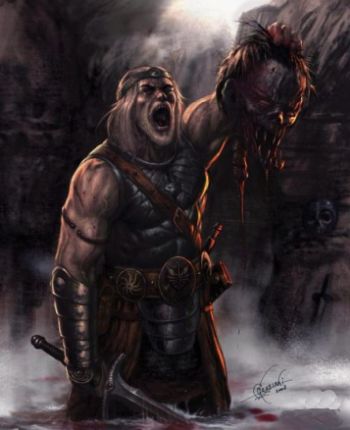
Beowulf remerges triumphantly to the surface with Grendel's head in his hand.
Also in the ancient English poem about Beowulf the hero dives to the bottom of the water and kills a monster.
The Old poem of Beowulf tells that the Gothic Prince Beowulf traveled to the court of the Dane king to free him from the terrible monster, Grendel, who ravaged his halls at night, killing and devouring his men. Beowulf managed to injure Grendel mortally, when the monster at night sought another meal in a hall, where Beowulf and his men were awaiting him. Grendel dragged himself back to his lake, seeking refuge in the deep water. However, the King's halls were now became attacked by Grendel's mother, who wanted to take revenge on her son. Beowulf got dressed in a magic armor and dived into the depths of the lake to do away with the monster. He came to an underwater cave, where he fought with Grendel's mother and overcame her with the help of a magic sword. He found Grendel's corpse in the cave and cut off his head. With this in hand, he triumphantly emerged to the lake's surface. Digital drawing by Kristin Ishaya - Pinterest.
Another story about Erlang tells, that a man named Zhao Yu of the emperor was given the task of fighting a vicious river dragon. With his double-edged sword in hand, he jumped into the river. There he killed the dragon. The river water turned red with its blood. When he emerged to the surface, he held his double-edged sword in his right hand and the had the head of the dragon in his left. The whole people kneeled in reverence.
They raised a temple to his honour called "The god of Erlang of Guankou". When the rivers flood, the God can still be seen riding a white horse in the mist over the streaming water.
A third story of Erlang and his seven friends and followers says, that they were seven holy men from the coal mountain. Because they helped a tyrant with his evil deeds, they were all killed by Nezha and Yang Jian. According to "The Chronicle of Chengdu Prefecture" all the seven were hunters and friends of Erlang. It is also said, that they had a very distinctive appearance, and they also were called "The seven monsters." All these give associations to the folk-tale about "Snow-white and the seven dwarfs".
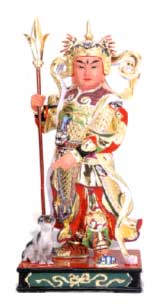
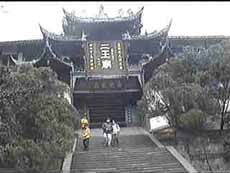
Left: The god Erlang.
Right: The Erwang Temple in Guanxian in Sichuan.
The name Erlang means: "second son". The God Erlang has adouble edged weapon, which gives associations to the Roman god Neptun. He has a third eye on his forehead, which is an Indo-European feature.
In ancient times stood the statues of Erlang's seven friends and followers in the Erwang Temple in Guanxian of Sichuan. This temple, however, has been destroyed and rebuilt many times during the history, and their statues may no longer exist.
Erwang means "Two Kings". It's called such because both Erlang and his father over time got the status of kings. However, many call it the Temple of Erlang.
|
Den Aeldre Eddas Gudesange - Google Books Archive.com Dvaergenes skabelse starter side 62. Asernes aet - Dvaerge Verasir Voelvens Spaadom v. Olaf Hansen Heimskringla |
| To top |